Earn Your First $100 on the Side: 12 Creative Ways to Make Money

The average salary in the United States is almost $48,000. But with the cost of living slowly creeping upward, it’s no surprise you’re turning to the internet with one question: “How can I make my first $100 on the side?”
Rest assured, you’re not alone. A 2019 survey from BankRate found that 37% of Americans have found extra ways of making money—each earning an average of $686 per month. People with successful side projects may have been more likely to respond, but it still demonstrates that money can be made on the side of most full-time jobs.
However, the attraction of a side hustle isn’t just limited by the opportunity to pad your wallet. Sure, you can use the extra cash to grow your savings account, travel more, and eventually quit your job if your venture becomes successful. But learning how to build and sell products and services on the side also offers several related benefits:
- Security. A day job can offer stability, but it also puts your earning potential all in one basket. If you lose your job, you lose your only source of income. Diversifying with a job on the side means you’ll still have cash if the worst happens.
- A new hobby. A hobby is something that you want to do but don’t have to do. Creative people tend to cross-pollinate their hobbies and day jobs. Hobbies are something fun to do, yet they sometimes have spillover benefits for your day-to-day work. They give you another place to learn and grow, even if your day job (or another important activity) has hit a wall.
- Building your money-making skill set. Making money is its own distinct skill—one you need to practice if you want to turn interests and talent into a sustainable business. Even if a specific side project doesn’t reach its full potential, you’ll still build valuable skills that can be applied to your next idea.
Can everyone make money on the side?
There’s a misconception that people need to be extremely skilled or need to quit their full-time job to make money online. The truth: you don’t need either of those to start a venture on the side.
Take Sandy from this episode of Guess My Hustle. Spoiler alert: We’re going to give away the answer.
Sandy’s an accountant by trade and started her own dog boutique store that curates different canine-related items—such as leashes, collars, and treats—from all over the world. She sells the products her pup wears on her website, Spotted by Humphrey.
Sandy’s side business grew from an Instagram account that shared the products Humphrey loved. Her content has attracted over 100,000 followers and led to her online pet retail store being profitable while she was still holding down her accountancy job.
Or look at James Yurichuk, the pro CFL footballer. Like many other players in the league, James needed additional work to support the income from his “day job.” He and his wife were living in an apartment, with a child on the way, and needed extra cash to support their growing tribe.
But James didn’t have any knowledge about how business works, especially the fashion business—which is the industry he entered when he started Wuxly Outerwear.
The idea sprung to mind when the cold Toronto weather led to James looking for a coat for his wife. The only problem: he couldn’t find one made without animal-derived materials. He partnered with an old friend who happened to be a tailor and created Wuxly Outerwear as a solution to premium winter coats that don’t contain animal products.
12 creative ways to make money
Below are 12 unconventional ways to earn your first $100 on the side. They prove you don’t need any remarkable skills or experience, or tons of spare time:
- Sell your photos
- Print on demand
- Teach online classes
- Sell food waste
- Recommend your favorite products
- Rent your unused space
- Sell your services
- Productize industry-specific skill
- Host tours in your city
- Test websites
- Sell your art
- Train your dog
We’ll break down each side business idea by:
- Business type: whether the idea is product-based or service-based, or driven by an audience.
- Effort: how much time, skill, or experience you’ll need to put into the idea.
- Leverage: how well positioned you are to turn the idea into a money-making one that increases in value without needing your direct attention. A high-leverage idea isn’t a 1:1 trade of time for money.
- Startup costs: the upfront budget you’ll need to launch the idea.
- Profit potential: how much profit you can expect to make from your idea per year.
1. Sell your photos
Business type: Product-based
Effort: Medium
Leverage: Low
Startup costs (out of 5 💸): 💸
Profit potential (out of 5 💰): 💰💰
Modern smartphones have high-quality cameras. The iPhone 11 Pro, for example, has a triple lens with wide angles and optical zoom.
It’s no surprise then that the ever-increasing quality of smartphone cameras has crashed the camera industry. Mid-level cameras were made obsolete when your phone began offering the same quality with 10x the convenience. You carry your smartphone wherever you go.
But instead of leaving your photos to sit idly in the cloud, you can potentially turn your snapshots into cash—and your smartphone is all the equipment needed to make money on the side while expressing your creative side.
Photographs are like any other product, and in order to successfully sell your photography you need to target an audience of potential customers who want or have a need for them. Start by thinking about the photography style you’re most interested in, whether that’s landscapes, portraits, or pets. Then, depending on how you plan to monetize (e.g., by selling prints or offering rights to stock photography sites), see if there’s a specific lane or niche you can identify. For example, you may notice that photos of papercraft creations are in demand on stock photography sites but that the current supply is limited. That’s a potential opportunity.
The Haute Stock library was born out of this concept. Its founder, Rachel Rouhana, was “frustrated with the lack of stylish stock photography available for women business owners.” So she created Haute Stock to fill that gap in the market.
Once you’ve found your niche, start building a following on visual-heavy platforms like Instagram or Pinterest. Snap some niche-specific photos, use a free photo editor to polish them up, then sell them on sites like Adobe Stock, Shutterstock, and TourPhotos.
Monitor which style works best through the platform’s analytics. Pinterest, for example, shows how many link clicks a photograph has had. Are there any similarities between your top-performing photographs?
Use your social media accounts to tease your paid content—bloggers and business owners always need stock photos. You could pitch directly to your target business owner, asking whether they’d be willing to pay for your photos—and how much they’re willing to pay. For example: you might identify the audience for your pet-related photos as dog retailers who are willing to pay $25 per stock photo.
Bear in mind that you’ll need to price your stock photos on three factors: The demand for photos in that industry, the price competitors are charging, and the fees you’re paying to take the photos themselves. If you're shooting people, you'll need to pay them, and if you're shooting locations you'll usually need permission or to pay a fee. Build this into your pricing to make sure you’re not losing more money than you’re making.
By selling your images through one of these platforms, you could turn your hobby into your first $100 on the side.
2. Print on demand
Business type: Product-based
Effort: Low
Leverage: High
Startup costs: 💸💸
Profit potential: 💰💰💰
Print on demand is a low-risk way to make money that, unlike traditional dropshipping, lets you leverage your creative talents. Here’s how it works: you work with a supplier to customize (or white label) products such as books, t-shirts, phone cases, or other merchandise. You add your design to a plain item, then the supplier prints and delivers your products to customers on a per-order basis so you don’t have to hold inventory in order to start selling.
Since you can take the lion’s share of logistics and operations work off your plate, thanks to Shopify apps like Printful, Lulu xPress, and Printify, you’ll have more time to focus on design, branding, and marketing your products. It’s a very accessible business model if you’re working a full-time job. You can get creative with your own talents or commission a freelance designer to help you with patterns or full-blown product designs.
Since your customized products will be manufactured once a customer places an order, you also won’t have to pay for the items until you’ve sold them.
Print on demand is a superb model for creatives who want to get involved with their products, but don’t have time to commit to making or manufacturing them. It combines the ability to be expressive and to build a distinct brand with the ease of dropshipping, making it a nice sandbox to creatively make money.
Start a print-on-demand business
3. Teach online classes
Business type: Audience-driven
Effort: High
Leverage: Medium
Startup costs: 💸💸💸
Profit potential: 💰💰💰💰
Turning your industry knowledge into an online course is a smart way to make extra money—even as a complement to an existing product-based business. Take Babbel for Business and LashPro Academy. Both online courses have a niche customer base yet still bring in extra money for the course creators.
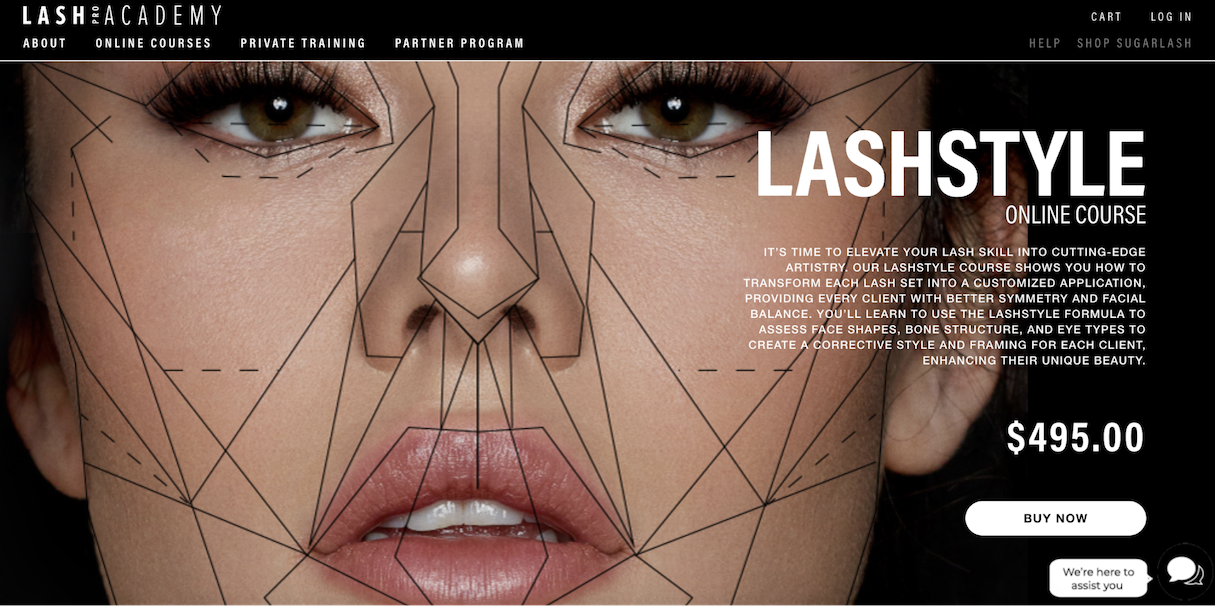
You can start making money by teaching classes in an area you’re interested in. What can you talk about for hours on end? What do your family and friends ask for your advice on? The answers are likely a great class idea. But remember, a huge part of any online course’s success is the audience who purchases it. Some niches might not be as profitable as others, so check whether there’s high demand for your course topic before investing time in creating it. Generally speaking, you want to look for audiences willing to pay money in order to make progress. Passionate hobbyists or professionals who are willing to invest in their craft are a prime example.
Next, plan the flow of your course. Think about the topics you want to cover and create content for each section. This could be a one-off lesson sold as a class or a curriculum of content on a similar theme offered as a course.
You can host and distribute your content on platforms like Shopify, Udemy, Teachable, SkillShare, or LinkedIn Learning, all of which allow creators to monetize their course. This offers an added bonus versus selling a course through your own site by giving you a built-in distribution tool.
Sure, you’ll need to spend some time promoting your course. But once you’ve invested time in creating the content, your investment is basically done. The time and money you spend developing the course is upfront, meaning you’ll only need to fork out marginal costs if and when you update it.
4. Sell food waste
Business type: Product-driven
Effort: Medium
Leverage: Low
Startup costs: 💸💸
Profit potential: 💰
Every year, we throw out more than $990 billion worth of food. This includes items beyond their best before date or that don’t look their best—including those with small marks or deemed the wrong size. You can collect this otherwise wasted food and monetize it.
Take farm produce. Farmers are often unable to send unsightly vegetables to a supermarket for sale, even when they’re perfectly edible. This food often gets tossed in the trash. You could ask for their “wonky” vegetables and sell them at a discount to people in your city. Farmers can do this themselves at a farmer’s market, but you can offer to do it for them if they sell the products to you at a lower cost. There’s an added benefit for the farmers: they won’t need to go to the markets themselves and can spend their time producing crops.
Or you could take advantage of apps like OLIO or Farmdrop. Give the discounted-rate products a new lease of life and use them to create something new—such as a recipe you batch-make and sell at a weekly market stall.
This idea is not only a smart, creative way to make money, but it's a win-win. You’re making cash out of unwanted food, which in turn helps save the environment. Instead of getting tossed into a landfill, the food is reused and eaten.
5. Recommend your favorite products
Business type: Audience-driven
Effort: Low
Leverage: Low
Startup costs: 💸
Profit potential: 💰💰
Chances are, you’ve got a list of products you couldn’t live without. You refer one of those products to your friend, and they soon feel the same. Affiliate marketing is a way to monetize your passion for helping people connect with the right product.
The affiliate marketing model works by recommending products to your network and receiving a bonus—usually a percent of the sale price in commission or gift cards—as a reward. Most companies, including Amazon, Uber, and eBay, offer a refer-a-friend incentive.
You could take things a step further by recommending your favorite products to a bigger audience through blogging or posting on social media.
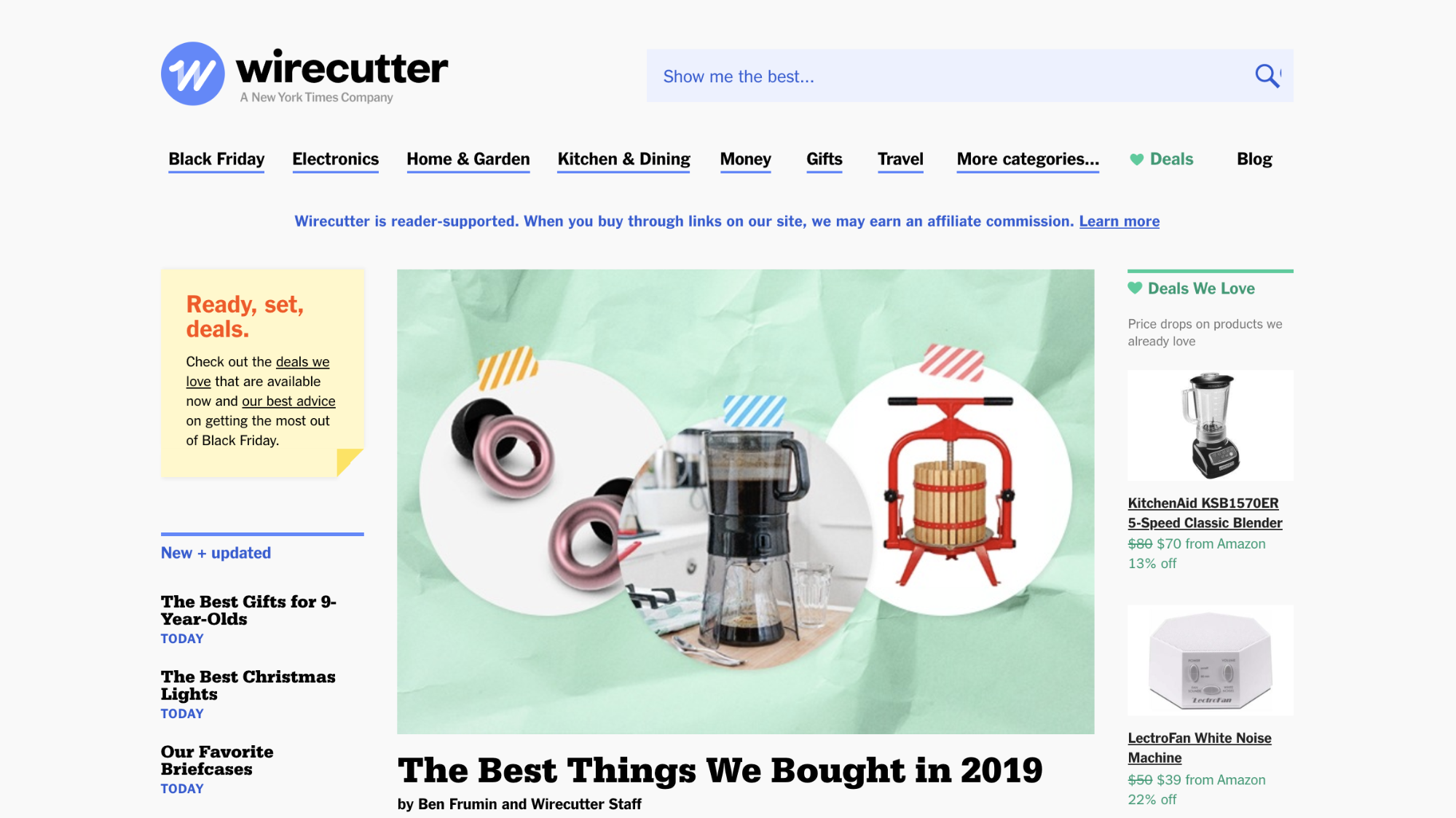
This is how most influencers and bloggers make money aside from offering sponsored posts. The Wirecutter and BuzzFeed, to look at two examples, both employ staff writers and freelance contributors to write review-focused content that’s monetized with affiliate links. Affiliates receive a commission when their audience purchases based on their recommendation.
These reviews aren’t spammy—there’s no pushy feeling that forces you into making a purchase just because the influencers will receive a commission. Their reviews are in-depth, unbiased, and genuinely make it easier for you to find the right product.
That’s the basic idea of great affiliate marketing: providing additional education and context that can be challenging for the official company to present in a genuine way. Affiliate content is formed around unbiased options, simply referring products you enjoy.
It’s relatively easy to get started with affiliate marketing—particularly if you’re an existing customer of a brand. Search the brand’s website and see if it offers a refer-a-friend program. (If it doesn’t, you can always email to enquire.) Ask friends to use your link or code when they purchase from that brand and you’ll both get a reward.
6. Rent your unused space
Business type: Product-driven
Effort: Low
Leverage: Medium
Startup costs: 💸
Profit potential: 💰💰
The average US household has 52 unused items, worth a combined $3,100, ranging from old clothing to toys and furniture. You can make cash from those items by upcycling or selling them, but you’ll probably have something more valuable that you can rent rather than sell.
One example is your backyard. You can treat it as a side-hustle opportunity by listing it on camping websites or Airbnb and charging people to pitch their tent there. Create boundaries with the people you open your camping space to—such as whether they’re allowed to use your indoor toilet, access your home, or light barbecues on your grass. You might also want to consider limiting your space to a specific group of people, like families or those with young children. Even if you charge just for the pitch space, it’s a superb option for making your first $100 on the side.
You also can partner with Rent the Backyard. It’ll build a small apartment in your yard for free and split the profits with you when you rent it out. The company’s website says a homeowner in San Francisco could make up to $12,000 in their first year. But bear in mind that this is a big commitment in return for the large paycheck.
Similarly, for a small monthly fee you could rent the parking space that comes with your home or apartment to family, friends, or one of the many drivers who spend 17 hours per year looking for a parking spot—a huge source of frustration for commuters. This is an especially great side-hustle idea if you use the car space but aren’t at home during the day to use it.
The amount you’ll earn depends on where your parking space is. New York, for example, has an average monthly parking cost of $600—but people in downtown Austin pay just $219 per month.
You can use sites like Parkopedia or Craigslist to check out your competition. Find what people in your location are charging for their parking space, then price your spot competitively. Pop into local offices and ask whether any staff would be interested in hiring your spot.

7. Sell your services
Business type: Service-driven
Effort: High
Leverage: Low
Startup costs: 💸
Profit potential: 💰💰💰💰
The gig economy is on the rise. An increasing number of people are performing work as independent contractors or freelancers who work for other organizations on a flexible or temporary basis to earn money online.
That’s probably why freelancing or service-based businesses are the second-most popular ways to make money, with 64.8 million people in the US expected to be freelancing in 2020.
You can get involved by selling your services. Think about what you’re good at or want to learn. There’s probably a company looking to employ someone like you but probably on a project basis, not a full-time contract.
Once you’ve found your special skill, start getting experience on sites like Upwork, TaskRabbit, or Fiverr. Be wary that other freelancers, especially those who don’t know how to position their services, might charge pennies for similar work, and that there’s a risk of pricing way too low to beat them in the battle for clients. A great place to start is the average hourly rates for the specific profession in your country. The average hourly rate for a marketer in the US, for example, is $33.
Decide what services you could offer by looking at the skills you’ve nailed in your day job:
- Are you praised for the way you organize your email inbox? You could make a great virtual assistant.
- Do you communicate with co-workers and summarize your meeting minutes for your team? The leap to writing isn’t too far.
- Can you listen to a client and deliver exactly what they want? You could offer party planning services for people in your area.
You could also take a look at the tasks you enjoy doing or those you’d like to develop. Let’s say you’re working in a marketing agency as your full-time job. You enjoy social media posting but don’t enjoy advertising. You could reach out to clients who only want social media content and offer that as your standalone service. Just make sure there isn’t a non-compete clause in your full-time contract. (It’s worth chatting with your boss to double check.)
You’ll also need to decide on a schedule for your side gig. Some companies hire remote staff that don’t need to be present in the office. Look for that type of role if you’d prefer the flexibility that comes with remote-friendly work. Similarly, if you thrive being around other people or find that kind of work isolating (even on the side), offer to join other companies in their office when you’re free. You’ll do the same work—just in their office.
You might need to spend a while creating your portfolio—a collection of work that proves you’re good at the service you’re selling—before you can demand higher rates.
However, you can start with lower rates and potentially use your service offering as a springboard to starting your own business. First, see whether there’s a demand for your service, whether you can fit the work into your schedule, and how much clients are willing to pay you. You might find a hidden business opportunity to make this income stream your main one.
Service-based side businesses are high-margin, can be very profitable, and quick to pay off. But the downside is they’re usually a bit harder to scale into an asset that can run without you. You are your business—you’ll need to be on-hand to do the work, or at least oversee it if you grow to the point where you’re able to subcontract work to another freelancer and maximize profit.
8. Productize industry-specific skills
Business type: Product-driven
Effort: High
Leverage: High
Startup costs: 💸💸💸
Profit potential: 💰💰💰💰💰
You’ve found a skill you’re good at and you’ve started monetizing it by offering a service to clients. But you spend so much time with your clients that you realize there’s a gap in the market for a product you could sell.
Tracey Hicks is a real estate agent and independent business owner who found herself creating small notebooks to keep track of her clients. It dawned on her that other agents would probably benefit from these notebooks too, so she started selling them on her Shopify store.
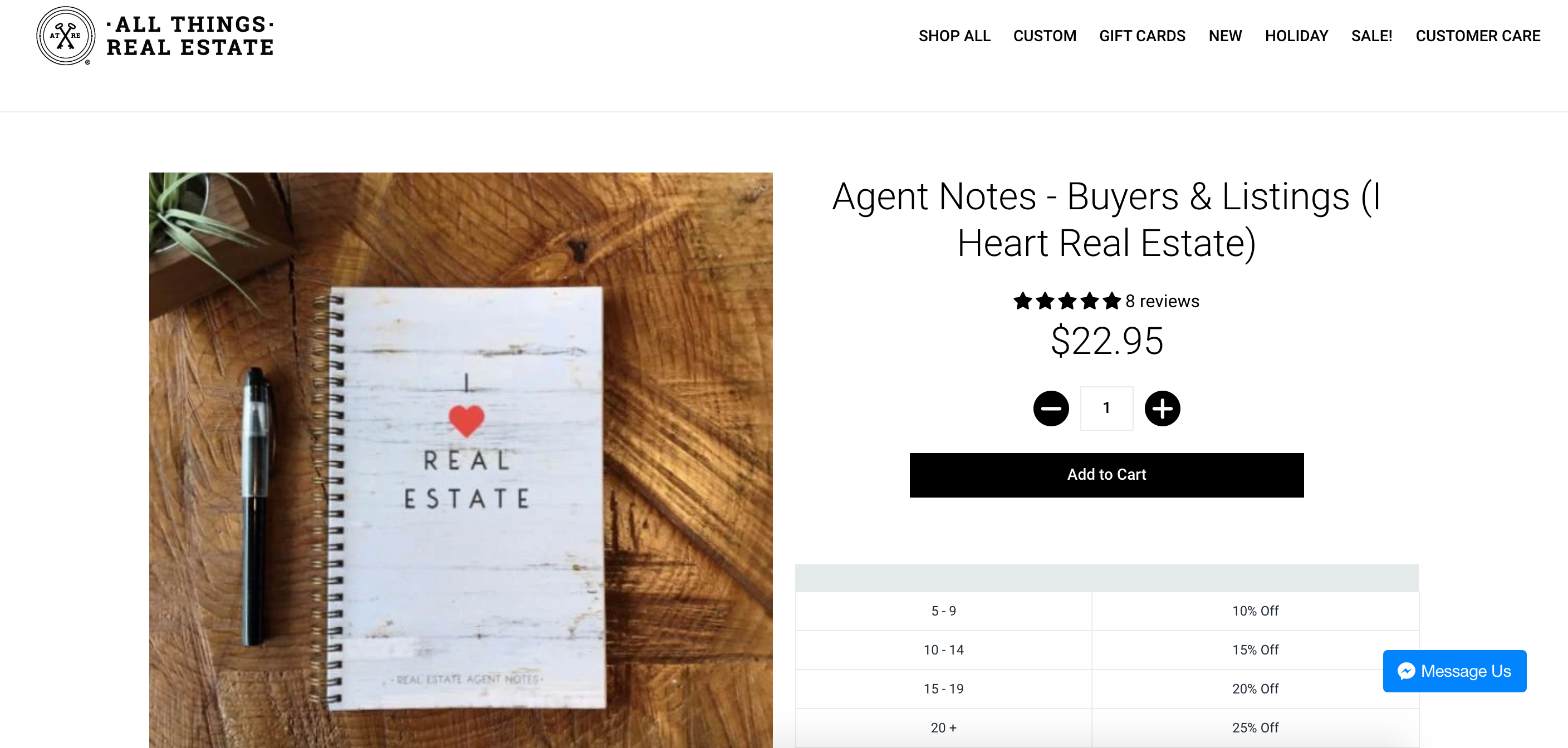 Find a skill you excel at or a tool you've created that makes your life easier and launch a niche product to help people who suffer the same problem.
Find a skill you excel at or a tool you've created that makes your life easier and launch a niche product to help people who suffer the same problem.Another example is Dustin Lee. He noticed that graphic designers were always looking for add-ons to their standard tools, such as paintbrushes, design elements, Photoshop templates, and clip art. So he created RetroSupply, which sells those products directly to other designers instead of design clients.
This follow-on from selling your services will only work if you understand your clients. You might need to land a few freelance gigs before spotting a gap in the market—but that’s a silver lining. Business ideas present themselves more noticeably when you’re in the weeds and living with the problems yourself.
9. Host tours in your city
Business type: Service-driven
Effort: High
Leverage: Medium
Startup costs: 💰
Profit potential: 💸💸💸
If you live in a tourist city, there’s an opportunity to host tours to visitors.
These can be niche—like a tour of a famous monument—or activity specific, such as general walking, bike, or alcohol tours. Think about what you’re knowledgeable about and start to plan the route of your tour. You might need to create a script or fact sheet to explain areas of your city to your attendees.
Then, start to think about how you can find people to join your tour. You could create your own website and optimize it for keywords your tourists are likely searching, such as:
- “Walking tours in CITY”
- “Bike tours in CITY”
- “Cheap CITY tours”
Rely on SEO tactics for this part. Then, arrange a date, time, and meeting point with the tourists who enquire.
But if you don’t fancy that upfront commitment, you can join platforms like ShowAround. List yourself as a host and start meeting people who plan to visit your city. Take a look at the value propositions that people in your area are offering—like Lexie in London:
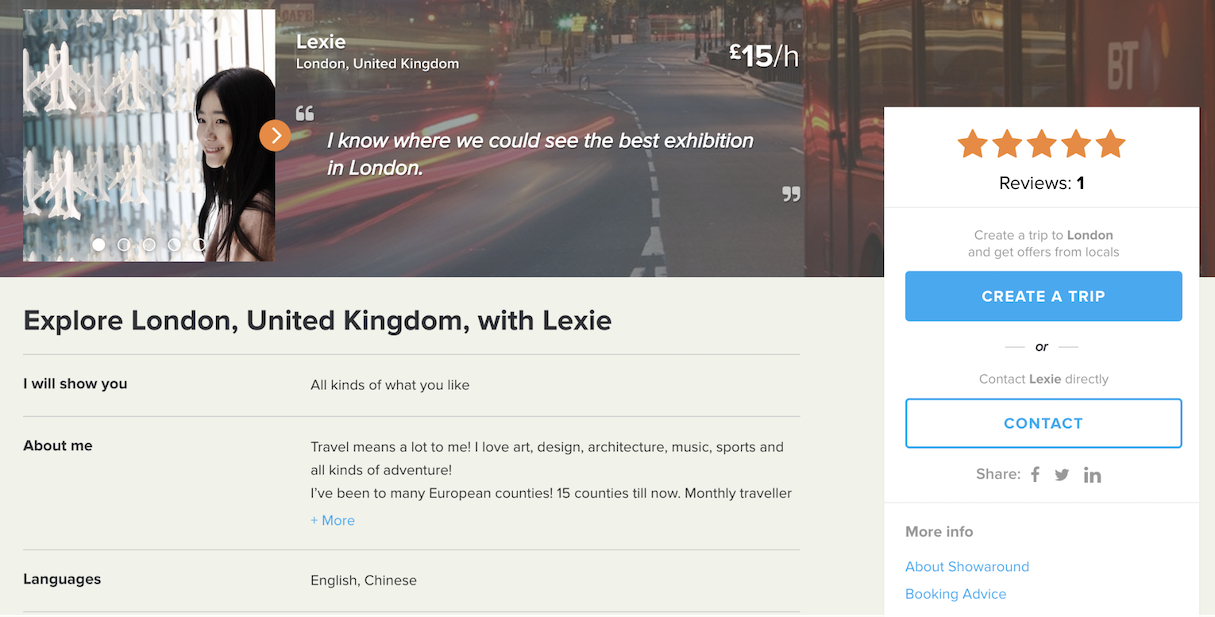
Like Lexie, you might be up on where the best exhibition is in your city. Or maybe you’re aware of a fantastic restaurant that only locals know. Think about what you have to offer a tourist that they might not have seen or done before.
You’ll be making friends while also earning extra cash.
10. Test websites
Business type: Service-driven
Effort: Low
Leverage: Low
Startup costs: 💸
Profit potential: 💰
You form an impression of a website when you visit it, and companies are always looking for feedback on their site. So you could get paid for sharing your thoughts, whether it’s on design, content, or usability.
For people who have spare time at an office—maybe on their lunch break, this is a creative way to make money. Sites like UserTesting pay $10 per 20-minute test, which might not sound like much, but if you do one every lunch break for two weeks, these small tasks will have earned you your first $100 on the side.
Similarly, you can volunteer to take part in focus groups. Designers, copywriters, and marketers are always looking for feedback on their new campaign. You could email them and volunteer your time to help, asking for a small incentive—like a cash reward or gift card—in return for your time and opinion.
11. Sell your art
Business type: Product-driven
Effort: High
Leverage: High
Startup costs: 💸💸💸
Profit potential: 💰💰
If you’re a budding artist, selling your work is using your creativity to make money.
It’s a simple way to make money from your hobby—especially when you combine it with the print-on-demand model. Transfer your illustrations onto a physical product (like a t-shirt or coffee mug) and create an online store for your items. You’ll only pay the fee for the item once you sell the product.
Or you could create an online library of your artwork. Work on building a following, then offer quick, personalized art in return for a small fee. This is a great way for budding artists to work on their craft, making extra money on the side and building an audience as they grow. Sites like Buy Me A Coffee allow people to donate the cost of a coffee in return for your custom work.
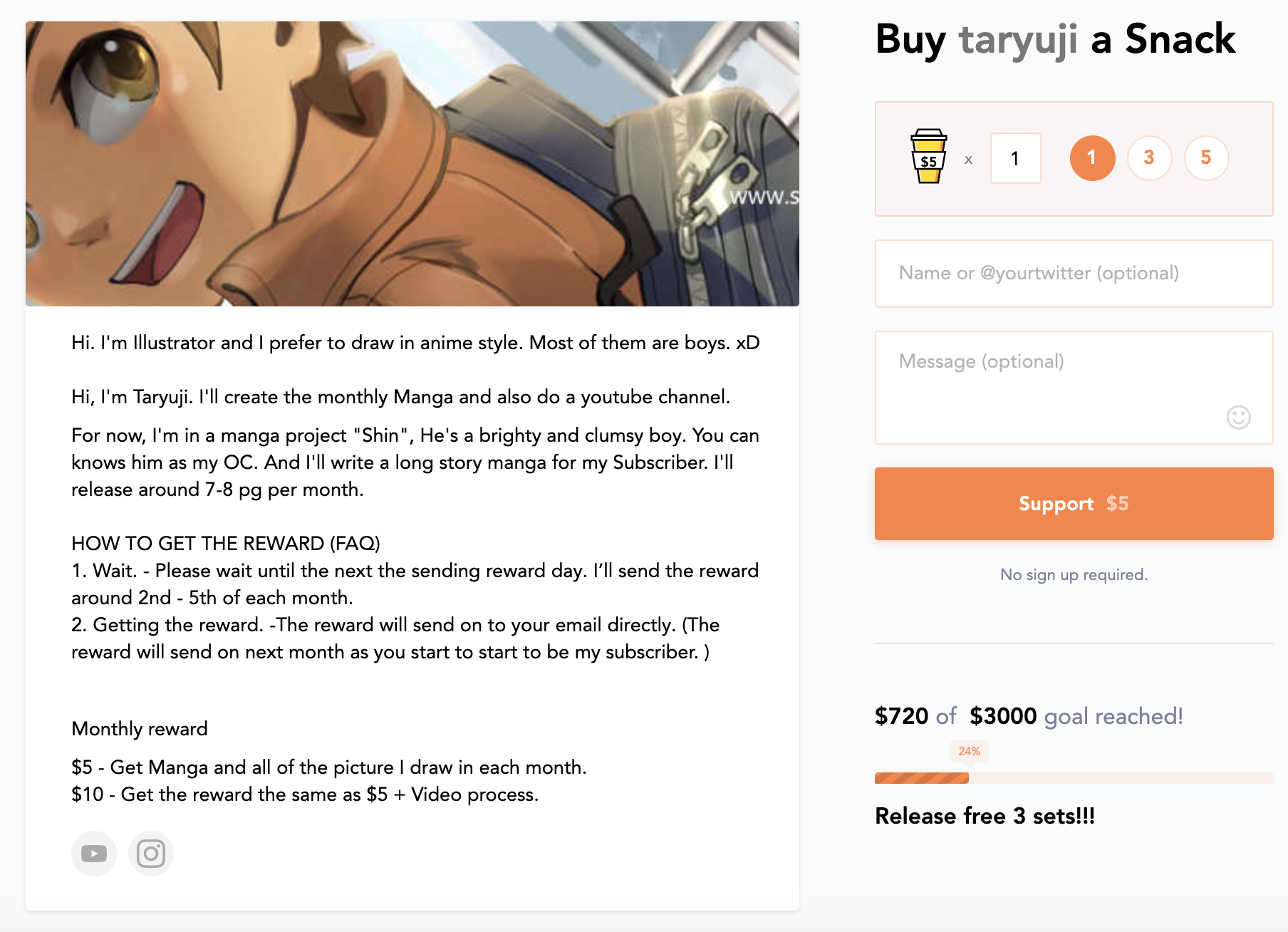
Talented artists can combine their art with a service and offer made-to-order illustrations. Both businesses and the general public often look for custom illustrations through sites like Etsy or Fiverr.
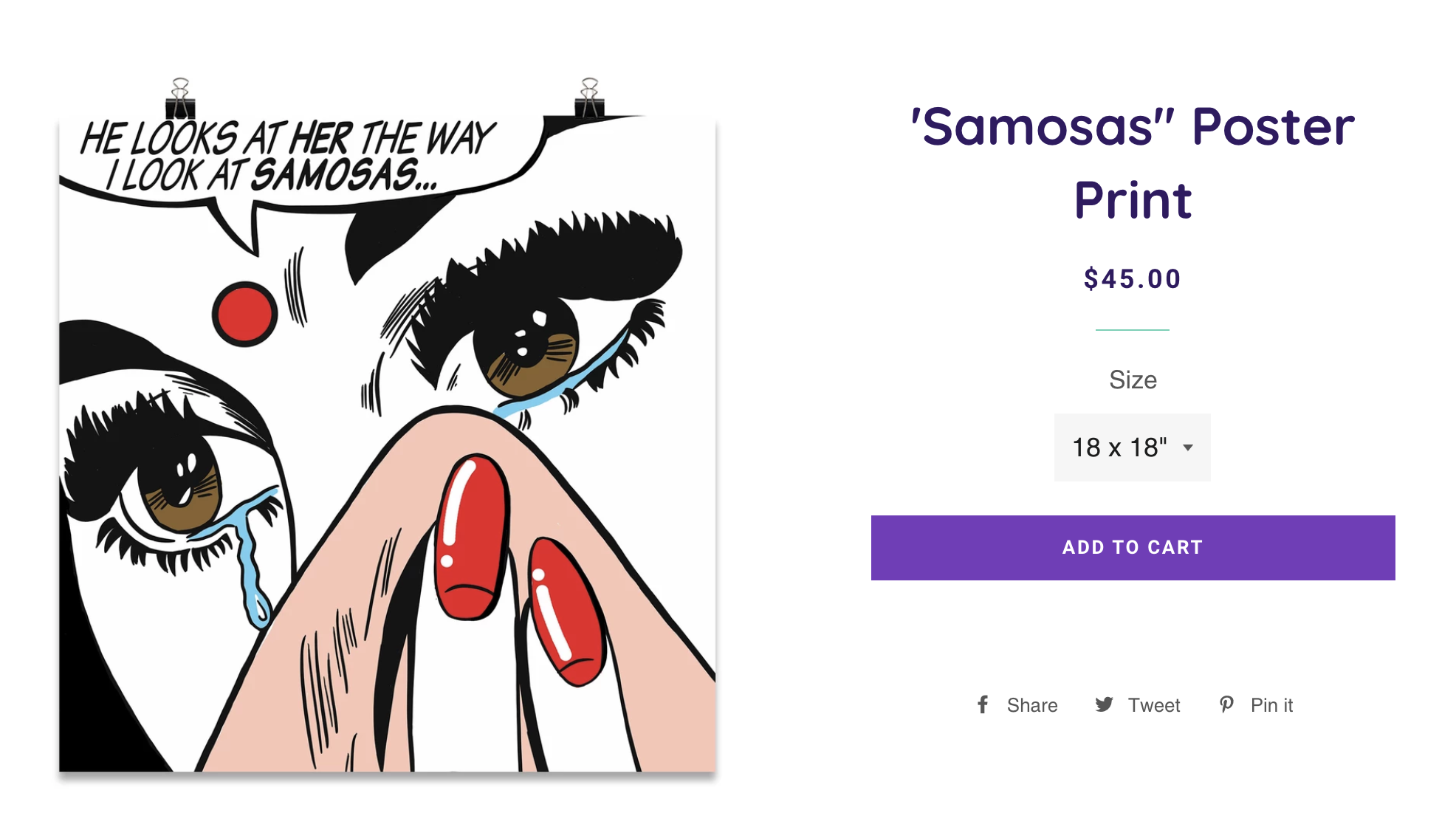
Alternatively, you can use Shopify to sell your art directly to customers. You’re able to print several copies of your work and sell them through your own online shop. This means you can set your own pricing, manage your inventory, and have full control over your illustrations.
And the earning potential doesn't just stop with visual art. If you're a musician, you might consider selling music along-side print-on-demand merch. If you're a talented sculptor, you could sell customized home decor. Combining art and entrepreneurship is a great way to make money doing something you love.
Ready to create your first business? Start your free trial of Shopify—no credit card required.
12. Train your dog
Business type: Audience-driven
Effort: Medium
Leverage: Low
Startup costs: 💸
Profit potential: 💰
If you’re looking for a fun way to make money on the side with your furry friend, this is it. You could pick up some training skills on YouTube and practice them your dog. Not only will it build a bond with your pet, but you never know—it could lead to movie roles or teaching other people how to train their dogs.
Ashleigh Butler entered Britain’s Got Talent with her well-trained dog, Pudsey. Their appearance resulted in a movie, a handful of theatre performances, and multiple TV spots.
You don’t need an exceptionally talented pet, either. You’ll learn how to confidently handle dogs throughout your training, meaning you can use sites like Rover to offer pet-sitting services or start your own dog walking business.
Ready to make your first $100 on the side?
Instead of following conventional advice, these offbeat, creative money-making ideas make it more likely you’ll find a side hustle where passion and profit overlap—without too much competition.
Whether you’re selling your art, offering a niche skill, or simply renting something you own that people want, remember that a new income stream typically takes time to build momentum. It’s worth building for the long term—potentially with the plan to quit your day job and take your new venture full-time—when you find an idea that you enjoy.
These unconventional ideas are different than your typical money-making tasks, but they all need a creative person to do one thing: connect the dots between what people want and outside-the-box solutions you can use to give it to them.